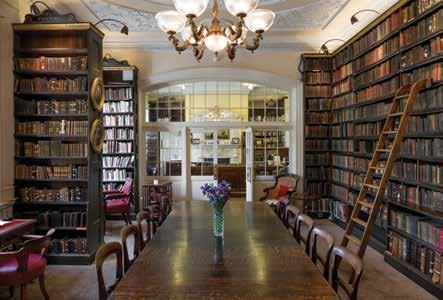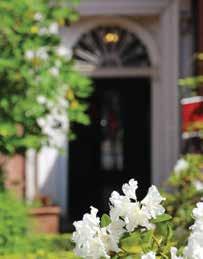
3 minute read
BROMLEY HOUSE LIBRARY
Our series on independent historic libraries continues with a profile of a haven for bibliophiles in Nottingham by Martin Stott, a trustee of the institution
It has always been easy to miss the heavy wooden door nestled between the grimy windows of a Barnardo’s charity shop and a newsagent. It is even easier at the moment as the building is buried in scaffolding.
Behind that doorway, and up the decorative, lead-covered stairway, lies the room at the heart of Bromley House Library in Nottingham. It is magical – mahogany bookcases, a grandfather clock, books from floor to ceiling and a wroughtiron spiral staircase that entices you further upwards (‘one person at a time please’) to a balconied gallery. Glass doors to the side lead into one of those library rooms you see in stately homes – the kind that are roped off, leaving you staring wistfully at the shelves and teasing armchairs beyond.
This is Bromley House Library. It was created in 1816 and moved into this gorgeous Grade II* listed Georgian townhouse five years later. It has just won a much-needed £386,000 grant from English Heritage to replace the 267-yearold roof, hence the web of scaffolding.
For years a heavy downpour has had staff running around the attics with buckets and calling in the roofer to do another urgent patch job. When the new roof is completed the bookcases in the attics will be modernised and lighting updated. Children’s books will be moved up here into a room with a Narnia wardrobe leading to a small chamber of books behind. It should become a draught-free space for more of the soft armchairs that are currently dotted around the building, encouraging people to rest and read.
There are around 50,000 books here, including some rare treasures and particularly good selections of early travel books and theology. Around a thousand new books are purchased each year. These are a broad mix of publications recommended by members – from a history of the Opium Wars to poems about cats.
This balance between popular and ‘intriguing eclectic’ may help explain why membership has more than doubled in the past decade to nearly 1,700. You constantly stumble on pleasant surprises among the shelves. An annual household membership cost of just £104 may be another contributory factor in the library’s success. Credit also goes to the knowledgeable and welcoming staff, who will enthusiastically introduce readers to
Left Inside Bromley House Library, Nottingham. © Martine Hamilton Knight. Above Rear door from the members’ garden.

new authors and who organise stimulating talks on a wide variety of topics.
Like many of Britain’s subscription libraries, Bromley House promises a sanctuary – a place of precious calm – in a cacophonous world. But there is one thing it offers that no other library can: a meridian line. A brass strip runs from the foot of the window in the newspaper reading room, diagonally across the floor. The observant might notice that one of the panels in the window has been boarded with a piece of thin wood out of which has been cut a hole the size of a two-pence coin.
This means that on a sunny day, towards midday, a disc of light is cast on to the floor. As noon strikes, the disc hits the middle of the brass strip. When the mathematician George Green and his fellow Bromley House members were first using this building in the first half of the nineteenth century, this was how they kept accurate time. Today, a chart on the wall helpfully warns us that midday at Bromley House is 4 minutes 36 seconds behind Greenwich mean time.
This is a place where it feels comfortable to be behind the times.







